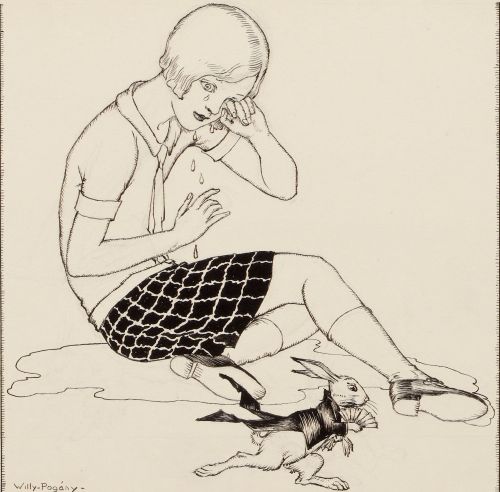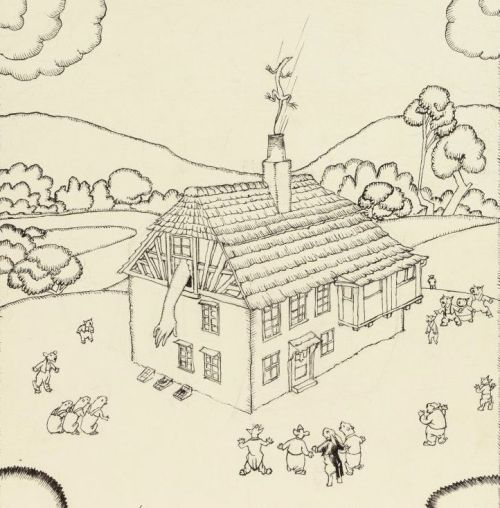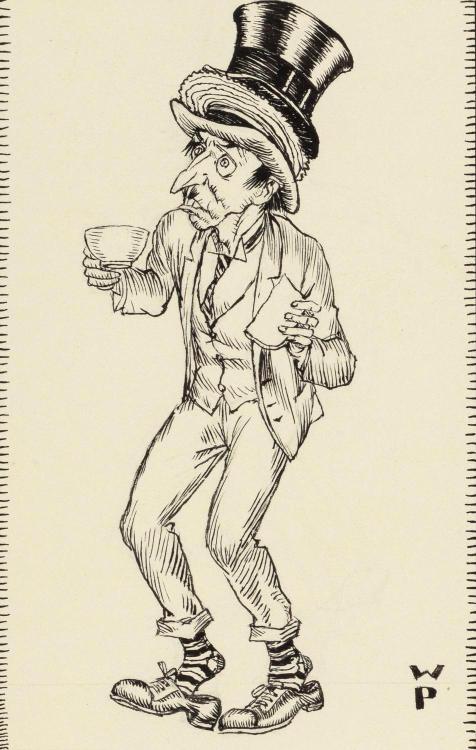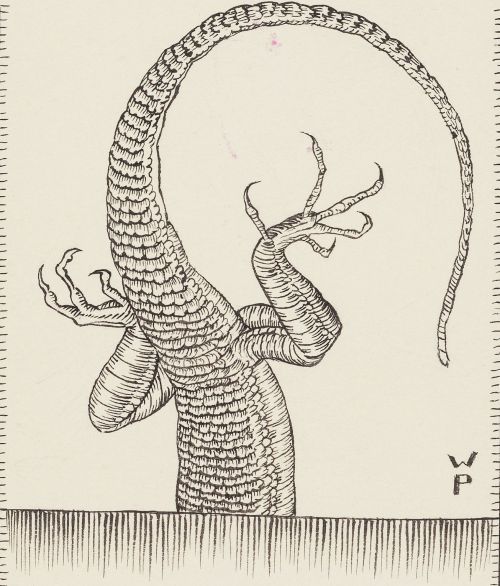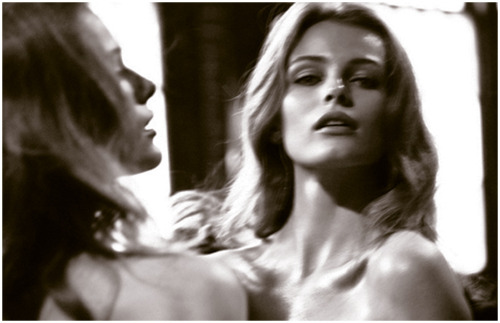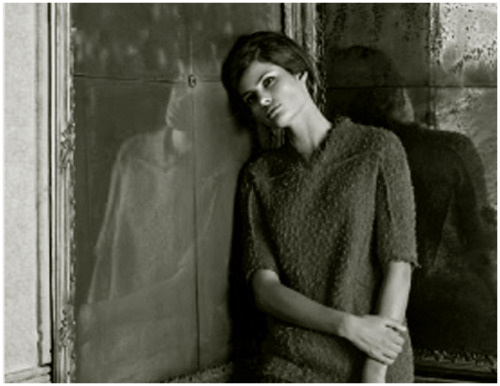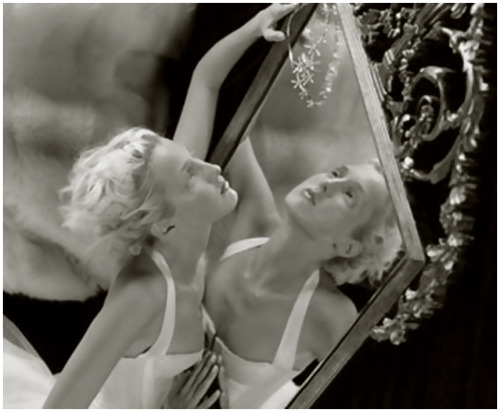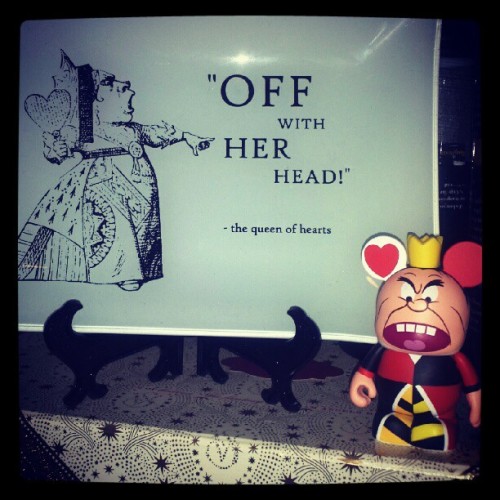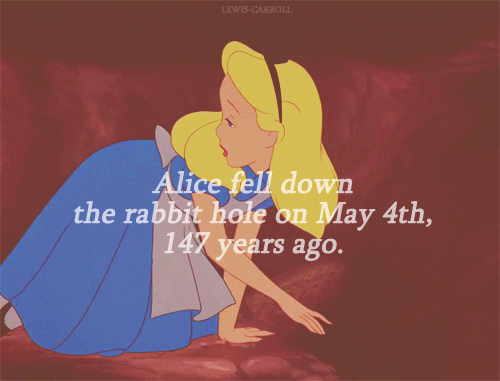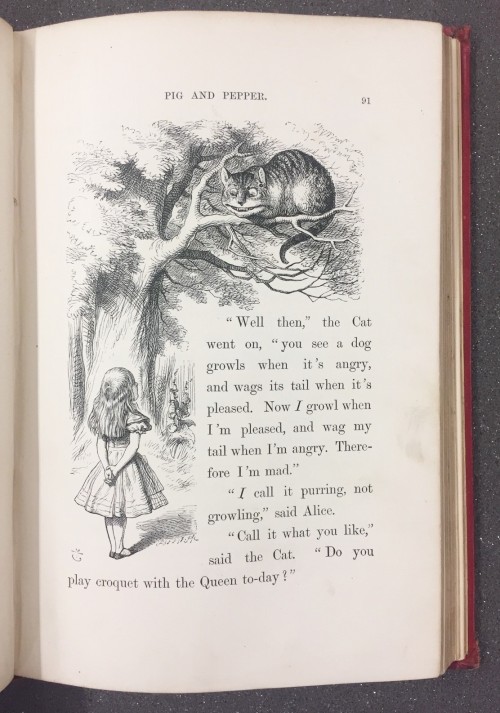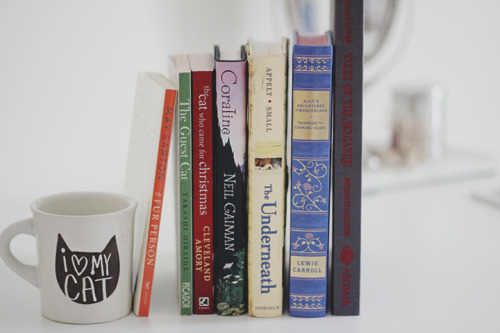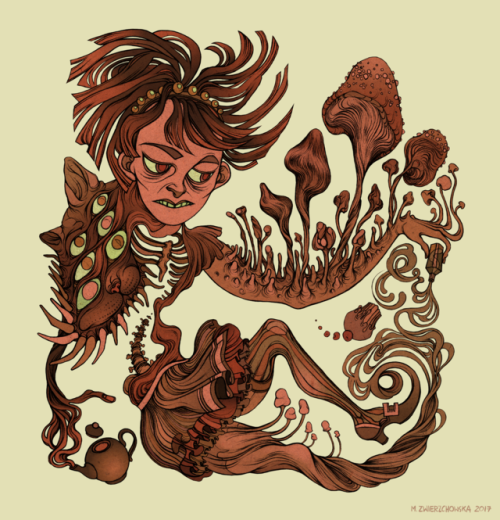#lewis carroll
This is how I feel if I’m experiencing derealization/dissociation. Can y’all relate?
From my edit account on insta - @i.e.saudade
- Six Forty Seven (Instupendo)
Alice through the looking glass : -
This collection of Fashion campaigns has been inspired by Lewis Carroll’s literary work [a sequel to Alice in Wonderland]. Take time to reflect…….Voir
Post link


Quarantella #20, Short clips I make in one day using things I find at home, while quarantined in Italy.
This is “ ‘Twas brillig” from Disney’s “Alice in Wonderland”, based on Lewis Carroll’s Jabberwocky of course.
Beyond the Enlightenment Rationalists:
From imaginary to probable numbers - VI

(continued from here)
“O Oysters, come and walk with us!” The Walrus did beseech. “A pleasant walk, a pleasant talk, Along the briny beach: We cannot do with more than four, To give a hand to each.”
* * *
“The time has come,” the Walrus said, “To talk of many things: Of shoes–and ships–and sealing-wax– Of cabbages–and kings– And why the sea is boiling hot– And whether pigs have wings.”
-Lewis Carroll, The Walrus and the Carpenter
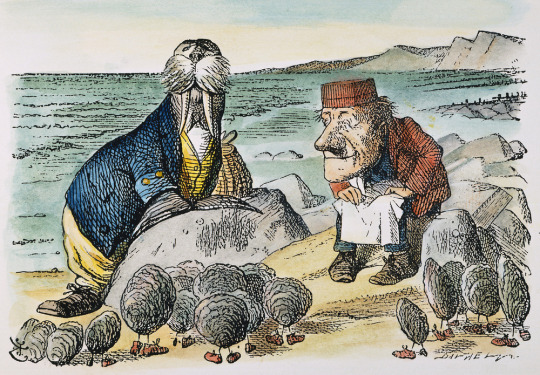
In this segment, probable numbers will be shown to grow out of a natural context inherently rather than through geometric second thought as transpired in the history of Western thought with imaginary numbers and complex plane. To continue with development of probable numbers it will be necessary to leave behind, for the time being, all preoccupation with imaginary numbers and complex plane. It will also be necessary to depart from our comfort zone of Cartesian spatial coordinate axioms and orientation.
Probable coordinates do not negate validity of Cartesian coordinates but they do relegate them to the status of a special case. In the probable coordinate system the three-dimensional coordinate system of Descartes maps only one eighth of the totality. This means then, that the Cartesian two-dimensional coordinate plane furnishes just one quarter of the total number of corresponding probable coordinate mappings projected to a two-dimensional space.[1] It suggests also that Cartesian localization in 2-space or 3-space is just a small part of the whole story regarding actual spatial and temporal locality and their accompanying physical capacities, say for instance of momentum or mass, but actually encompassing a host of other competencies as well.
Although this might seem strange it is a good thing. Why is it a good thing? First, because nature, as a self-sustaining reality, cannot favor any one coordinate scheme but must encompass all possible - if it is to realize any. Second, because both the Schrödinger equationandFeynman path integral approaches to quantum mechanics say it is so.[2] Third, because Hilbert space demands it. This may leave us disoriented and bewildered, but nature revels in this plan of probable planes. Who are we to argue?
So how do we accomplish this feat? Well, basically by reflections in all dimensions and directions. We extend the Cartesian vectors every way possible. That would give us a 3 x 3 grid or lattice of coordinate systems (the original Cartesian system and eight new grid elements surrounding it), but there are only four different types, so we require only four of the nine to demonstrate. It is best not to show all nine in any case because to do so would place our Cartesian system at direct center of this geometric probable universe and that would be misleading. Why? Because when we tile the two-dimensional universe to infinity in all directions, there is no central coordinate system. Any one of the four could be considered at the center, so none actually is. Overall orientation is nondiscriminative.[3]
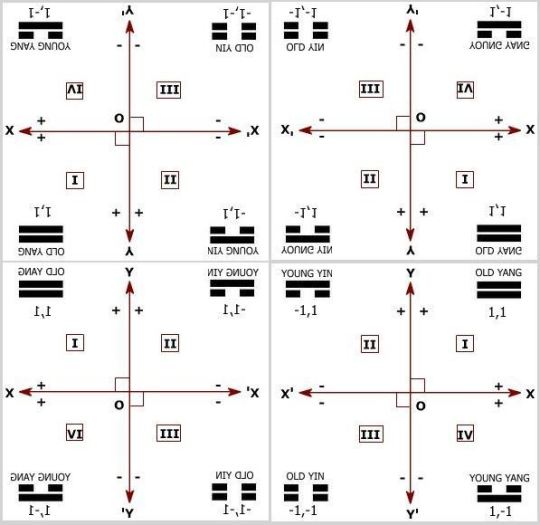
LOOKING GLASS CARTESIAN COORDINATE QUARTET
The image seen immediately above shows four Looking House Cartesian coordinate systems, correlated within a mandalic plane. This mandalic plane is one of six faces of a mandalic cube, each of which is constructed to a different plan but composed of similar building blocks, the four bigrams in various positions and orientations. A 2-dimensional geometric universe can be tiled with this image, recursively repeating it in all directions throughout the two dimensions.[4] It should not be very difficult for the reader to determine which of the four mandalic moieties references our particular conventional Cartesian geometric universe.[5]

It remains only to be added here and now that potential dimensions, probable planes, and probable numbers arise immediately and directly from the remarks above. In some ways it’s a little like valence in chemical reactions. We’ll likely take a look at that combinatory dynamic in context of mandalic geometry at some time down the road. Next though we want to see how the addition of composite dimension impacts and modifies the basic geometry of the probable plane discussed here.[6]
(to be continued)
Top image: The four quadrants of the Cartesian plane. These are numbered in the counterclockwise direction by convention. Architectonically, two number lines are placed together, one going left-right and the other going up-down to provide context for the two-dimensional plane. This image has been modified from one found here.
Notes
[1] To clarify further: There are eight possible Cartesian-like orientation variants in mandalic space arranged around a single point at which they are all tangent to one another. If we consider just the planar aspects of mandalic space, there are four possible Cartesian-like orientation variants which are organized about a central shared point in a manner similar to how quadrants are symmetrically arranged about the Cartesian origin point (0,0) in ordinary 2D space. But here the center point determining symmetries is always one of the points showing greatest rather than least differentiation. That is to say it is formed by Cartesian vertices, ordered pairs having all 1s, no zeros. That may have confused more than clarified, but it seemed important to say. We will be expanding on these thoughts in posts to come. Don’t despair. For just now the important takeaway is that the mandalic coordinate system combines two very important elements that optimize it for quantum application: it manages to be both probabilistic and convention-free (in terms of spatial orientation, which surely must relate to quantum states and numbers in some as yet undetermined manner.) At the same time, imaginary numbers and complex plane are neither.
[2] Even if physics doesn’t yet (circa 2016) realize this to be true.
[3] It is an easy enough matter to extrapolate this mentally to encompass the Cartesian three-dimensional coordinate system but somewhat difficult to demonstrate in two dimensions. So we’ll persevere with a two-dimensional exposition for the time being. It only needs to be clarified here that the three-dimensional realization involves a 3 x 3 x 3 grid but requires just eight cubes to demonstrate because there are only eight different coordinate system types.
[4] I am speaking here in terms of ordinary dimensions but it should be understood that the reality is that the mandalic plane is a composite 4D/2D geometric structure, and the mandalic cube is a composite 6D/3D structure. The image seen here does not fully clarify that because it does not yet take into account composite dimension nor place the bigrams in holistic context within tetragrams and hexagrams. All that is still to come. Greater context will make clear how composite dimension works and why it makes eminent good sense for a self-organizing universe to invoke it. Hint: it has to do with quantum interference phenomena and is what makes all process possible.
ADDENDUM (12 APRIL, 2016)
The mandalic plane I am referring to here corresponds to the Cartesian 2-dimensional plane and is based on four extraordinary dimensions that are composited to the ordinary two dimensions, hence hybrid 4D/2D. It should be understood though that any number of extra dimensions could potentially be composited to two or three ordinary dimensions. The probable plane described in this post is not such a mandalic plane as no compositing of dimensions has yet been performed. What is illustrated here is an ordinary 2-dimensional plane that has undergone reflections in x- and y-dimensions of first and second order to form a noncomposited probable plane. The distinction is an important one.
[5] This is perhaps a good place to mention that the six planar faces of the mandalic cube fit together seamlessly in 3-space, all mediated by the common shared central point, in Cartesian terms the origin at ordered triad (0.0.0) where eight hexagrams coexist in mandalic space. Moreover the six planes fit together mutually by means of a nuclear particle-and-force equivalent of the mortise and tenon joint but in six dimensions rather than two or three, and both positive and negative directions for each.
[6] It should also be avowed that tessellation of a geometric universe with a nondiscriminative, convention-free coordinate system need not exclude use of Cartesian coordinates entirely in all contextual usages. Where useful they can still be applied in combination with mandalic coordinates since the two can be made commensurate, irrespective of specific Cartesian coordinate orientation locally operative. Whatever the Cartesian orientation might be it can always be overlaid with our conventional version of the same. More concretely, hexagram Lines can be annotated with an ordinal numerical subscript specifying Cartesian location in terms of our local convention should it prove necessary or desirable to do so for whatever reason.
On the other hand, before prematurely throwing out the baby with the bath water, we might do well to ask ourselves whether these strange juxtapositions of coordinates might not in fact encode the long sought-after hidden variables that could transform quantum mechanics into a complete theory. In mandalic coordinates of the reflexive nature described, these so-called hidden variables could be hiding in plain sight. Were that to prove the case, David Bohm andLouis de Broglie would be immediately and hugely vindicated in advancing their pilot-wave theory of quantum mechanics. We could finally consign the Copenhagen Interpretation to the scrapheap where it belongs, along with both imaginary numbers and the complex plane.
ADDENDUM (24 APRIL, 2016)
Since writing this I’ve learned that de Broglie disavowed Bohm’s pilot wave theory upon learning of it in 1952. Bohm had derived his interpretation of QM from de Broglie’s original interpretation but de Broglie himself subsequently converted to Niels Bohr’s prevailing Copenhagen interpretation.
© 2016 Martin Hauser
Please note: The content and/or format of this post may not be in finalized form. Reblog as a TEXT post will contain this caveat alerting readers to refer to the current version in the source blog. A LINK post will itself do the same. :)
Scroll to bottom for links to Previous / Next pages (if existent). This blog builds on what came before so the best way to follow it is chronologically. Tumblr doesn’t make that easy to do. Since the most recent page is reckoned as Page 1 the number of the actual Page 1 continually changes as new posts are added. To determine the number currently needed to locate Page 1 go to the most recent post which is here. The current total number of pages in the blog will be found at the bottom. The true Page 1 can be reached by changing the web address mandalicgeometry.tumblr.com to mandalicgeometry.tumblr.com/page/x, exchanging my current page number for x and entering. To find a different true page(p) subtract p from x+1 to get the number(n) to use. Place n in the URL instead of x (mandalicgeometry.tumblr.com/page/n) where
n = x + 1 - p. :)
-Page 311-
Posso explicar uma porção de coisas, mas não posso explicar a mim mesma.
Alice no País das Maravilhas - Lewis Caroll
Portamanteau is, like most words with too many letters, French. It first appeared in the 1540s, where it refereed to the guy who carried the mantle of the prince, from ‘porte’ (think 'porter’) and 'manteau’ (think 'mantle’). It took about fourty years for that word to mutate from the 'person’ part of a noun to the 'thing’ part, coming to refer to a type of suitcase.
And then, in 1882, some douchebag (you may have heard of him) decided it should have an entirely new meaning, and that meaning stuck. Since you can pack two things up at once in a suitcase– or a portamanteau– you can certainly pack two meanings up in one word.
And so a word completely changed its meaning due to some guy thinking it was a good idea at the time.
“A Caucus Race And A Long Tale,” illustration from Lewis Carroll’s Alice’s Adventures In Wonderland by John Tenniel, 1865
Post link

Hello readers!
For my 21st I decided I wanted to do a tea party. I’ve planned this since around May of 2014 so as you can see, it was a long time coming! I had a small group of friends I invited to the tea party because they are super close. Also the idea of baking for 30 is not a pleasant one.
It was really special too because it’s 150 years of Alice in Wonderland THIS year. Good timing eh?
So…
A very special edition of Alice in Wonderland… can’t believe I got my hands on it!

Backstory: I’m turning 21 on 16th February. I’m doing an Alice in Wonderland ‘Mad Hatters’ tea party (which I’ll probably blog about too) so everything that is related to Alice, I go I NEEEED IT.
I had been hauling vintage tea cups, whilst at the Antique shop my mum found this. It’s in really great condition for how old it is. I got it for £3 which was a steal! So I whipped out my camera, to take…
Death of Lewis Carroll
14 January 1898
English author Lewis Carroll died in Guildford, England, at the age of 65 on this day in British history, 14 January 1898. Carroll’s real name was Charles Lutwidge Dodgson. He is most remembered for his pair of ‘Alice’ stories, Alice’s Adventures in WonderlandandThrough the Looking-Glass, What Alice Found There. Carroll spent most of his life as a mathematics lecturer at Christ Church, Oxford, and as a gentleman-photographer in some of England’s upper social circles.
Read more about Lewis Carroll’s life here….
http://todayinbritishhistory.com/2014/01/lewis-carroll-dies-guildford-age-65-14-january-1898/
Post link
“I wonder if the snow loves the trees and fields, that it kisses them so gently? And then it covers them up snug, you know, with a white quilt; and perhaps it says, "Go to sleep,darlings, till the summer comes again.”
Happy Birthday to illustrator and cartoonist Sir John Tenniel (1820-1914), born 200 years ago today (28 February), and perhaps best remembered for his illustrations in Lewis Carroll’s Alice’s Adventures in Wonderland (1865) and its follow-up novel Through the Looking-Glass and What Alice Found There (1871).
–
Lewis Carroll, Alice’s Adventures in Wonderland. London: Macmillan and Co., 1866, Alexander Turnbull Library, REng DODG Alic 1866.
Lewis Carroll, Through the Looking-Glass: and What Alice Found There. London: Macmillan and Co., 1872, Alexander Turnbull Library, REng DODG Alic 1872.
Post link

Inktober Día 23 -La casa del conejo
Antes de haberse acabado la mitad de la botella, se encontró con que su cabeza se apretujaba contra el techo, y tuvo que torcerla para no romperse el cuello. Se apresuró a dejar la botella, diciendo: «Ya es más que suficiente—Espero no seguir creciendo—Ya así como estoy, no puedo salir por la puerta—¡Ojalá no hubiera tomado tanto!»
Lewis Carrol: El hombre misterioso
Hoy se conmemora la muerte de Lewis Carroll, creador de la maravillosa historia de Alicia (Alice in wonderland) por la que hoy es famoso, pero además existen varios misterios que giran en torno a él.
Post link










HOW DISNEY USED A REAL MODEL TO DRAW ALICE IN WONDERLAND
Kathryn Beaumont (born 27 June 1938), the actor who voiced both Alice in Disney’s Alice in Wonderland and Wendy in Disney’s Peter Pan, also modeled for the animators. These photos show how much work was put into classical animation at the Disney studio.
Walt Disney chose Beaumont to be the voice of Alice when she was just ten years old. He chose her for the model of Alice. She was named a “Disney Legend” by the Walt Disney Company in 1998.
Made under the supervision of Walt Disney himself (1951), this film and its animation are often regarded as some of the finest work in Disney studio history, despite the lackluster, even hostile, reviews it originally received.
It gained popularity in the 1970’s due to the “drug” culture fandom at the time, it was released in 1974, and then again in 1981.
Today, it is not only considered the best animated film adaptation of Lewis Carrol’s novel but one of Disney’s greatest classics. { 1-10 }
I’ve lost count of the number of older works of fiction that some people refuse to take at face value. So many literary critics, when faced with an aspect of a classic book or play that they don’t like, will claim that it’s really a deconstruction or a satire, or that the author didn’t really want to write it that way, but reluctantly gave in to the mores of their time period. Whether it’s because the work is out of step with modern values, or because the tone is inconsistent, or because certain storylines play out differently than the critic wanted them to, or, very commonly, because the work is too romantic, too optimistic, etc., and not edgy and cynical enough, the critics cry “insincere author.”
We see this when people claim that Romeo and Juliet is really a satire or a deconstruction of a love story. Or when they claim that the ending of Wuthering Heights inconsistent with the rest of the book, and probably wasn’t the original ending Emily Brontë wrote, or that Jane Eyre’s happy ending is supposed to ring false and hollow. Or that the ending of Little Women is another false happy ending that’s actually supposed to be disappointing. Or many other examples.
Now I’ve seen this thinking applied to Alice in Wonderland too. Namely to the sentimental poems and gentle real-world scenes that frame both of the two books: the poem “All in the golden afternoon” that opens Alice’s Adventures in Wonderland and the reverie of Alice’s sister that ends the book, and Through the Looking-Glass’s framing poems “Child of the pure unclouded brow” and “A boat beneath a sunny sky” and its opening and closing scenes of Alice playing with her kitten.
I’ve now seen two people (composer Unsuk Chin in her notes on her opera adaptation, and an essay writer whose name I’ve forgotten) argue that these poems and scenes are tonally inconsistent with the rest of the text, and that they’re much more conventionally Victorian in their sentimentality and idyllic portrait of childhood than Alice’s dream adventures are in all their surrealism, humor, dark edges and cultural satire. Unsuk Chin wrote that Carroll was probably forced to give the books a conventional, sentimental framing, or else they would have been too radical for the era, and she suggested that he probably would have written very different opening and closing scenes if he had his own way. I also found an essay targeting the opening and closing poems, which suggested that they should be read as satirical, because their sentimental tone and their framing of the stories as simple, wondrous fairy tales for innocent children is so out-of-step with the books’ actual tone.
That’s an interesting idea that I had never considered before. I always have noticed that difference in tone between Alice’s adventures and the framing poems and scenes. But I’ve still always assumed that the framing sentimentality was sincere on Carroll’s part, and that this was part of the books’ complexity. The idea that it might really be satire never crossed my mind until now.
But to be honest, I still lean toward thinking they’re sincere. In the first place, Carroll’s satirical poems within Alice’s dreams (e.g. “How doth the little crocodile” and “You are old, Father William”) are obviously satire. Gleeful, wicked satire of the popular moralizing poems of the day. Not poems so subtly satirical that most people would think they were straight examples of the sentimental Victorian verses they parody. Secondly, in 1887, Carroll wrote an article called “Alice on the Stage,” in which he gave detailed descriptions of each of the book’s characters and what he thought of their portrayals in a recent stage adaptation. His description of Alice herself is very similar in tone to the framing poems and the affectionate reverie of the older sister at the end of the first book. He waxes very sentimentally about her loving, gentle, courteous nature, and of the innocence, joy, and wonderment of childhood that she embodies. Again, there’s a bit of a disconnect between the angel-child he describes and the character he actually wrote – is this girl, “loving as a dog and gentle as a fawn,” the same one who kicked Bill the Lizard out of the chimney and who remarked “I don’t think it’s a pity at all” when told that the Duchess was sentenced to death? But unless he meant this article as satire too, I can’t imagine after reading it that the books’ openings and endings are insincere in their tenderness.
Besides, as I pointed out, commentators are always trying to explain away aspects of classic literature that they don’t like by saying “It was meant as satire” or “The author was forced to write this by the mores of the time period.”
Still, the idea that the sentimental poems and framing scenes might have been meant as satire, or that they might have been concessions to Victorian taste so the books wouldn’t seem too radical, is worthwhile to consider. They are very different in tone from the surreal and satirical stories they frame, after all. I might personally view that difference as just a part of the books’ complexity (and as reflecting the complex, enigmatic character of the man who wrote them), but it’s worth exploring from every possible angle.

so i said there were 3 orwell references in this diorama that i cld spot
the first & namesake is on the two tins of tea :
pls note that i cannot make out the first name of the tea importers firm & have not yet been able to determine if its a real historic brand or not , google turning up no matches for an “and appleby” line from the 19th c on the steampunk / reenactment / collectibles fronts (x)
however the look of them is very authentic , the art style and colors are exactly in line w actual historic advertising & marketing materials from circa 1890 - 1910
& the symbolism of the adapted heraldry of great britain is quite in keeping w a brand aspiring to be awarded the honor of a royal appointment – or tryin to make casual shoppers think they already had one , hah !
but while to the vast majority of viewers this will symbolize at first & likely also 2nd glance ALICE IN WONDERLAND & THROUGH THE LOOKING GLASS bc tea –> parties (x) + lion & unicorn “were fighting for the crown” (x) = lewis carroll by default
there is something else , an obscure but super important essay by orwell from 1941
ie in the height of the blitz , during the battle of britain , but before the US had been bombed by the axis
after he & his wife had got back from the debacle of the spanish civil war
& it is called THE LION & THE UNICORN(x)
& begins w bombs falling from airplanes

& is a discussion of britain as a society & a culture & a govt as well as a changing one faced w a choice of directions imposed by war ( agn )
& in it , in the course of talking abt british culture , the “the nice cup of tea” - a subject so dear to his heart he wrote a whole other essay after the war on the right way to make tea (x) called just that -
& also the english love of flowers
all of which we see above in the CRIMSON PEAK display along w a chatelaine , a ring of keys - the key bein a symbol that features significantly in guillermo del toros previous films , both DEVILS BACKBONE & PANS LABYRINTH in literal / traditional fashion , & in more arcane modes in the HELLBOY films & CRONOS –& in BLADE 2 as in PACIFIC RIM more futuristic ones , but a key is a key if it be a puzzle-piece of metal or wood or a carefully guarded number sequence , or the DNA sequence of a member of the royal blood
–the key also oc simultaneously a longtime symbol of christianity , used heraldically esp by the church of rome , being associated w st peter the gatekeeper of heaven & equally of hekate the guardian of the crossroads of life & death , used in one of the most famous rites of that goddess long before christianity–
–one of the keys appears to have a skull finial altho the photo is not as high res as i wld like–
the moss-green doily under the tea service keys & morning paper bein significant @ least for its color as well as its floral symbols
but then there is the paper itself & upon closest examination i see that it does not say that LADY BEATRICE ALEXANDRA SHARPE ( ! ! ! ) was the victim , but that someone connected tp her by an “of” was slain in their bath
so the plot thickens
bc there is a ton of stuffs goin on uncovered via this orwell link
& mainly it hotwires directly to discworld
bc tell me if this does not speak muchly of ankh-morpork as described in those books ??
But here it is worth noting a minor English trait which is extremely well marked though not often commented on, and that is a love of flowers. This is one of the first things that one notices when one reaches England from abroad, especially if one is coming from southern Europe. Does it not contradict the English indifference to the arts? Not really, because it is found in people who have no aesthetic feelings whatever. What it does link up with, however, is another English characteristic which is so much a part of us that we barely notice it, and that is the addiction to hobbies and spare-time occupations, the privateness of English life. We are a nation of flower-lovers, but also a nation of stamp-collectors, pigeon-fanciers, amateur carpenters, coupon-snippers, darts-players, crossword-puzzle fans. All the culture that is most truly native centres round things which even when they are communal are not official - the pub, the football match, the back garden, the fireside and the ‘nice cup of tea’. The liberty of the individual is still believed in, almost as in the nineteenth century. But this has nothing to do with economic liberty, the right to exploit others for profit. It is the liberty to have a home of your own, to do what you like in your spare time, to choose your own amusements instead of having them chosen for you from above. The most hateful of all names in an English ear is Nosey Parker. It is obvious, of course, that even this purely private liberty is a lost cause. Like all other modern people, the English are in process of being numbered, labelled, conscripted, ‘co-ordinated’. But the pull of their impulses is in the other direction, and the kind of regimentation that can be imposed on them will be modified in consequence. No party rallies, no Youth Movements, no coloured shirts, no Jew-baiting or ‘spontaneous’ demonstrations. No Gestapo either, in all probability.
But in all societies the common people must live to some extent against the existing order. The genuinely popular culture of England is something that goes on beneath the surface, unofficially and more or less frowned on by the authorities. One thing one notices if one looks directly at the common people, especially in the big towns, is that they are not puritanical. They are inveterate gamblers, drink as much beer as their wages will permit, are devoted to bawdy jokes, and use probably the foulest language in the world. They have to satisfy these tastes in the face of astonishing, hypocritical laws (licensing laws, lottery acts, etc. etc.) which are designed to interfere with everybody but in practice allow everything to happen. Also, the common people are without definite religious belief, and have been so for centuries. The Anglican Church never had a real hold on them, it was simply a preserve of the landed gentry, and the Nonconformist sects only influenced minorities. And yet they have retained a deep tinge of Christian feeling, while almost forgetting the name of Christ. The power-worship which is the new religion of Europe, and which has infected the English intelligentsia, has never touched the common people.
beyond that but also bc that there is a great deal in this essay which is politically & socially relevant despite the changed times – esp the bit abt bein simultaneously exhorted to save for the war effort WHILE simultaneously exhorted to shop shop shop in the name of patriotism
something anyone who was a conscious adult i n 2002 will remember bein revolted by , or even just an alert teen of which there were many
even if there is a good deal i wld disagree w from my distant & hindsighted perspective , like for one i think orwell –yes , old george orwell himself ! ! is far more sentimental abt england & his countrymen than sir terry , esp when it comes to matters of war & empire & militarism
that ankh-morporkians happily ranting against “johnny klatchian” & “the cheese-eaters of quirm” are more true to the spirit of john bull & that eric blair is FAR too soft on the raj harsh on it tho he was in the light of his own experience in burma (x) & i think george monbiot cld have taught him a few things (x) or put them in better perspective @ least (x) –& i do wonder if there isnt also some cryptic connection w luc besson makin his last big movie abt a burmese protestor
bc here is the kicker
i have been goin thru all the watch books now w a close reading & a watchful eye for symbols & references that i might have missed or thought just a joke before
& MONSTROUS REGIMENT is not the first SHARPES RIFLES fanfic pratchett did altho it is more obv
& the earlier SHARPE fanfic / fixfic is also his LES MIS fanfic / fixfic
but also a very grim BATMAN fic –grimmer than anything alan moore or frank miller dared dream up – is NIGHT WATCH indeed
bc carcer is an evil vimes doppelganger & thus the joker to vimes noir batman who operates on the very broken jagged edge of the law in this one , seeking out the dangerous answer WHAT IS THE LAW ?? IS ‘ORDER’ FOUND IN OBEYING ORDERS – OR IN FOLLOWING THE ESSENCE OF THAT LAWFULNESS??
but it was also a dark & prescient take on the current reality of the War on Some Nouns WHICH IS STILL GOING ON
& CARCER IS A VERSION OF SGT OBEDIAH HAKESWILL played w vicious aplomb by the late great pete postlethwaite AKA THE NEMESIS OF SHARPE WHO JOINED UP FOR THE LOOTING
& if there is any doubt that sam vimes is richard sharpe HE EVEN MAKES A NAME JOKE ON IT TO LORD RUST ! ! !
however in the course of all this collision of memes pratchett did something else huge
bc he took the timelords , that most english of inventions in entertainment , & turned them into the MI-5 of the bondverse , that other oh so english of entertainments
& made them both as unenglish as cld be TIMEBENDERS AHEAD OF TIME & also lightly made them part of UNCLE bc entrance thru a clothes shop here in their 3rd outing
its a huge subversion & of both universes , bc the bondverse is all abt “ENGLAND PREVAILS” defending the neoraj of the angloamerican pax thru strength
& the timelords are all abt the status quo in the name of benevolent handsoffery but rly to protect their privilege until it all goes blooey - except for the erratic champion-but-also-tourist the doctor
& in pratchetts hands the order of the history monks is defending reality from exactly the sort of authority figures that orwell criticized in his praise of toads & hares (x)
I think that by retaining one’s childhood love of such things as trees, fishes, butterflies and - to return to my first instance - toads, one makes a peaceful and decent future a little more probable, and that by preaching the doctrine that nothing is to be admired except steel and concrete, one merely makes it a little surer that human beings will have no outlet for their surplus energy except in hatred and leader worship.(…) The atom bombs are piling up in the factories, the police are prowling through the cities, the lies are streaming from the loudspeakers, but the earth is still going round the sun, and neither the dictators nor the bureaucrats, deeply as they disapprove of the process, are able to prevent it.
but it was in FIFTH ELEPHANT that del toro found the key for makin the lost daughter & the unsaved child & the unwanted orphan ALL THE SAME SOLAR WOLF-CHAMPION FIGHTING THE ELDER GODS GENERATION AFTER GENERATION
& it is hella grim in its lead for the alchemy
bc there is a girl & a shoe in that tale as well but her story didnt have a happy ending
& also i know how it too is a bondverse fic by retconnection now
not just bc NIGHT WATCH made sam vimes into james that time round
but bc of yes PACIFIC RIM
oh & there are also evil & unredeemed versions of hermann & newt in NIGHT WATCH
even as discworlds hakeswill is defeated in it
bc this is not the SHARPE fanfic w the folksongs in it – no hagman & harris except on the barricades as the multitude ( see how they rise up … )
& as there are good ( or good-ish ) versions of them in UNSEEN ACADEMICALS
but that will have to go in another post bc rl stuff calls
but yes the great game they are playing has a point , the story isnt idle diversion @ least on the side of team resistance
& THE CAKE WAS ALWAYS A LIE – & orwells essay goes into that in quite some detail for its brevity
read in 2019. alice’s adventures in wonderland by lewis carroll
alice had begun to think that very few things indeed were really impossible.
Post link


